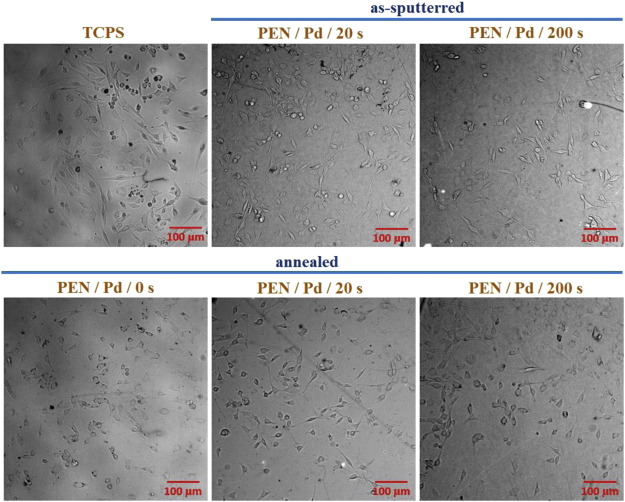 Non-conventional antimicrobial agents, such as palladium nanostructures, have been increasingly used in the medicinal technology. However, experiences uncovering their harmful and damaging effects to human health have begun to appear. In this study, we have focused on in vitro cytotoxicity assessment of Pd nanostructures supported on a biocompatible polymer. Pd nanolayers of variable thicknesses (ranging from 1.1 to 22A nm) were sputtered on polyethylene naphthalate (PEN). These nanolayers were transformed by low-temperature post-deposition annealing into discrete nanoislands. Samples were characterized by AFM, XPS, ICP-MS and electrokinetic analysis before and after annealing. Sterilization of samples prior to cytotoxicity testing was done by UV irradiation, autoclave and/or ethanol. Among the listed sterilization techniques, we have chosen the gentlest one which had minimal impact on sample morphology, Pd dissolution and overall Pd/PEN interface quality. Cytotoxic response of Pd nanostructures was determined by WST-1 cell viability assay in vitro using three model cell lines: mouse macrophages (RAW 264.7) and two types of mouse embryonic fibroblasts (L929 and NIH 3T3). Finally, cell morphology in response to Pd/PEN was evaluated by means of fluorescence microscopy.
Non-conventional antimicrobial agents, such as palladium nanostructures, have been increasingly used in the medicinal technology. However, experiences uncovering their harmful and damaging effects to human health have begun to appear. In this study, we have focused on in vitro cytotoxicity assessment of Pd nanostructures supported on a biocompatible polymer. Pd nanolayers of variable thicknesses (ranging from 1.1 to 22A nm) were sputtered on polyethylene naphthalate (PEN). These nanolayers were transformed by low-temperature post-deposition annealing into discrete nanoislands. Samples were characterized by AFM, XPS, ICP-MS and electrokinetic analysis before and after annealing. Sterilization of samples prior to cytotoxicity testing was done by UV irradiation, autoclave and/or ethanol. Among the listed sterilization techniques, we have chosen the gentlest one which had minimal impact on sample morphology, Pd dissolution and overall Pd/PEN interface quality. Cytotoxic response of Pd nanostructures was determined by WST-1 cell viability assay in vitro using three model cell lines: mouse macrophages (RAW 264.7) and two types of mouse embryonic fibroblasts (L929 and NIH 3T3). Finally, cell morphology in response to Pd/PEN was evaluated by means of fluorescence microscopy.
Keywords: annealing; antibacterial; assays; cytotoxicity; glass; morphology; nanostructure; palladium; polyethylene naphthalate; polymers; sputtering; sterilization
